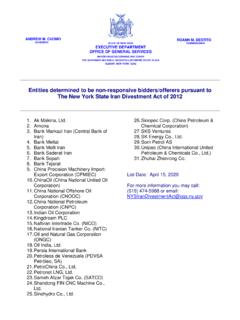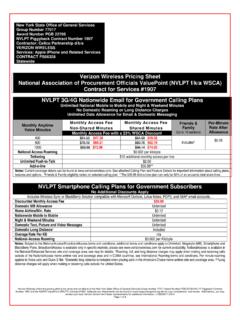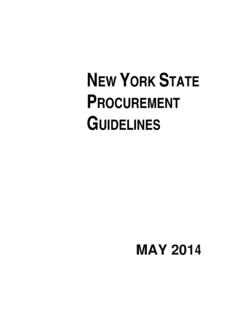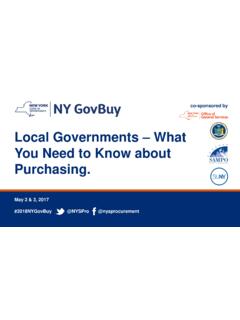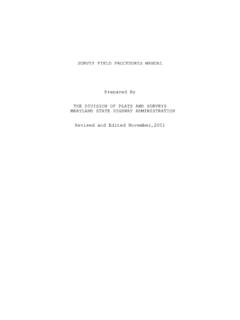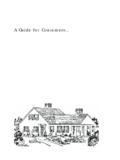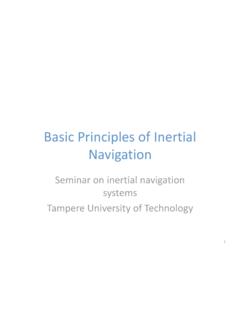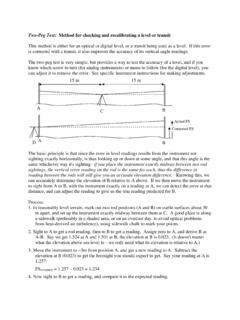Transcription of Standards & Procedures for Surveying and Mapping
1 Standards & Procedures for Surveying and MappingOctober 2014 2 Standards AND Procedures FOR Surveying AND Mapping October 2014 As written by the New York State Department of Environmental Conservation, amended by New York State Office of Parks, Recreation & Historic Preservation and amended for use by the New York State Office of General Services 3 Contents I. FORWARD .. 4 II. RESEARCH .. 5 III. Standards AND Procedures FOR FIELD SURVEYS .. 7 A. Field Surveys in General .. 7 B. Field survey Notes .. 8 C. Horizontal Control Specifications .. 9 D. Vertical Control Specifications .. 14 E. Computations .. 15 F. Boundary Monumentation .. 15 G. Boundary Marking .. 16 IV. Mapping .. 17 A. Size and Form .. 17 B. Material .. 18 C. Location Sketch .. 18 D. Title .. 18 E. Certification .. 19 F. survey Map Requirements .. 20 V. REPORT OF survey .. 21 VI. CONTRACTING FOR survey WORK .. 23 A. Proposals .. 23 B. Liquidated Damages .. 23 C.
2 Partial Payments .. 23 D. Materials to Be Submitted .. 24 VII. ADDITIONAL REQUIREMENTS .. 24 APPENDIX .. 26 4 I. FORWARD The New York State Office of General Services (OGS) is responsible for many programs that require the services of professional land surveyors. Quite often these services include Surveying , Mapping and boundary marking for the conveyance of land or land rights from private individuals to the State. Frequently, there is also a need for Mapping for planning or design purposes; re- survey and re-marking of old boundaries; and other specialized services consistent with programs within this office. Surveying staff in the Bureau of Land Management are generally responsible for the Surveying and Mapping . The purpose of this manual is to provide a standardized guide for land surveyors in the performance of Surveying and Mapping projects. All survey and Mapping performed for the OGS becomes part of the permanent records of the OGS.
3 It is considered public record and will be kept in perpetuity for use by the OGS, other state and local agencies and the public. All survey notes, computations, maps, tracings, and other documents and data in written and/or digital form pertaining to the work or to the project shall at all times be the property of the OGS. The type of Surveying or Mapping required for a project will be outlined in the contract with each consultant. Within this manual are Standards and Procedures for most of the services that might be required. When specified, these Standards and Procedures are to be considered a part of the contract. When there is a conflict between these Standards and contract specifications, the contract shall prevail. Boundary surveys will include research, field survey , field notes, computations, monumentation and marking of all state boundaries (including jurisdictional boundaries), a survey map, legal descriptions and a surveyor's report.
4 The Standards and Procedures for the preparation of maps and surveys are outlined in this booklet. Diagrams and samples illustrating some of the Procedures described herein will be found in the Addenda. 5 II. RESEARCH OGS will supply whatever material is readily available for the project from their files. This may include deeds, maps, abstracts of title, etc. In some cases little or no information is available. Abstracts or certificates of title are ordered by the OGS for all acquisition projects but are frequently not delivered until the project is well underway, or in some cases after the survey is completed. IT IS THE RESPONSIBILITY OF THE SURVEYOR to perform sufficient research to provide the basis for a complete and accurate survey . All rights-of-way, easements, boundary line agreements, exceptions or reservations that affect the property must show on the map with their correct location and dimensions. Copies of research material used to make these determinations shall be provided to the OGS at the completion of the project.
5 Research is not necessarily limited to data filed or recorded in the County Clerk's office. It is often necessary to conduct research at the offices of state agencies, town or county offices, utility companies, archives, or other offices where records may reveal data that affects the ownership or boundaries of the property. Interviews with owners and adjacent owners frequently reveal data that is valuable to the surveyor. Laws affecting Real Property While the majority of acquisitions completed by OGS are straightforward, on occasion the surveyor may encounter situations that will require additional knowledge of laws affecting real property. The following is a list a just a few: Real Property Law Education Law Eminent Domain Procedure Law Other situations that may arise could be: 1) Adverse Possession The courts generally hold that land owned by the State for a public purpose is NOT subject to adverse possession by others. Similarly, the State cannot obtain private land by adverse possession.
6 That is not to say that a deeded conveyance to the State extinguishes adverse possession rights that were matured prior to the State acquisition. A State acquisition would, however, stop the time clock and extinguish any rights that were in the process of maturing but had not completed the statutory time limits at the time the State acquires. Adverse possession claims are, of course, problems to be decided by a court of law. Knowledge of some of the basic rules can, however, prevent the surveyor from reaching erroneous conclusions. In considering possible adverse possession situations the surveyor should make he/she aware of the date of the State's acquisition and the statutory time limits in effect immediately prior to the acquisition. 2) Easements by Prescription 6 The courts have generally applied the same rules for easement by prescription over State land as they have to adverse possession. That is, an individual generally CANNOT obtain an easement by prescription over State land, nor can the State obtain and easement by prescription over private land.
7 7 III. Standards AND Procedures FOR FIELD SURVEYS A. Field Surveys in General The following items are standard for all field surveys conducted for the OGS unless specifically exempted by contractual specifications. When using GPS data collection methods OGS refers to the NYS Department of Transportation (DOT) Spatial Accuracy Standards as defined in the DOT Land Surveying Standards and Procedures Manual. 1) The New York State Plane Coordinate System shall be used on all surveys unless specifically instructed not to by the OGS. 2) Before commencing any field survey , every attempt should be made to contact all owners of property adjoining the parcel to be surveyed. Unless confidential, the nature of the survey should be explained to the adjoiner. The surveyor should request permission to enter upon the lands of the adjoiner for purposes of making the survey . 3) It is the OGS s policy that, on both public and private lands, surveys be conducted in a manner which minimizes damage to the property or environment.
8 Care and discretion should be used in all survey Procedures including cutting, witnessing, marking and monumentation. Where painting is necessary, lead-free paint shall be used. 4) It is expected that consultant surveyors shall comply with existing regulations for the State land area being surveyed unless specific exemption is granted. 5) All angles will be turned to the right or clockwise unless otherwise approved. Angular measurements will be performed with transits, theodolites or total stations with a least reading (direct) as shown in the table on page 12. 6) Distance measurements will be made with Electronic Distance Meters (EDM), total stations, or steel tape utilizing Procedures consistent with the Standards shown in the table on page 13. 7) All EDM's or total stations will be calibrated regularly (suggested schedule at least annually) against a standardized base line. A copy of the latest report of calibration shall be included in the Report of survey .
9 8) If steel tapes are utilized for traverse measurement they shall be standardized against a tape calibrated by the National Bureau of Standards . A copy of the Length Calibration Report and standardization form shall be included in the Report of survey . 9) All traverses which are utilized in locating evidence or determining boundary shall be closed in nature. A closed traverse may be a loop off a single point or start from one point of known location and close on another point of known location. Loop closure off a single point is not permitted for Primary traverses in Urban Class 8 surveys. 10) Distances measured by stadia, rangefinder, hip chain or like devices are not acceptable. 11) Where practical, existing, clearly defined property corner monuments that meet or exceed traverse station specifications should be occupied and observed as a traverse station. 12) The location and portrayal of improvements on the subject property will be required unless specifically exempted.
10 13) All improvements within 10 feet of an acquisition boundary, or a boundary being established by a resurvey, will be located and portrayed on the map with the offset distances from the boundary to the improvement. 14) All encroachment or evidence of trespass within the project area shall be located and portrayed as in item 12 above. 15) All evidence or indications of easements, rights-of-ways or use and occupancy by other than the reputed property owner shall be located and portrayed on the map. If location is not practical, a note explaining the circumstances should appear on the face of the map. 16) Wherever practical, the entire property from which a portion is to be acquired shall be portrayed on the map. B. Field survey Notes The format of the field notes shall generally be at the discretion of the surveyor. It is, however, required that the notes be easily interpreted by other users. All entries should be clearly labeled and the use of sketches to graphically portray the contents of the notes is strongly recommended for surveys recorded manually and electronically.


